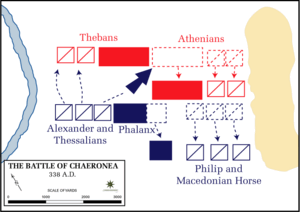Battle of Chaeronea (338 BC)
| Battle of Chaeronea | |||||||||
|---|---|---|---|---|---|---|---|---|---|
| Part of the Wars of Alexander the Great | |||||||||
 Battle plan of Chaeronea (338 BC) |
|||||||||
|
|||||||||
| Belligerents | |||||||||
| Macedon | Athens, Thebes |
||||||||
| Commanders | |||||||||
| Philip II of Macedon, Alexander the Great |
Chares of Athens, Lysicles of Athens, Theagenes of Boeotia |
||||||||
| Strength | |||||||||
| 30,000 infantry, 2,000 cavalry |
35,000 | ||||||||
| Casualties and losses | |||||||||
| 3,800 | 1,000 Athenians, 2,000 captured 254+ Boeotians, 3,000 captured |
||||||||
|
|||||
The Battle of Chaeronea 338 BC, fought near Chaeronea, in Boeotia, was the greatest victory of Philip II of Macedon. There, Philip (accompanied by allied contigents from Thessaly, Epirus, Aetolia, Northern Phocis and Epicnemidian Locrian) defeated the combined forces of Athens and Thebes and initiated Macedonian hegemony in Greece.[1]
Athenians and Thebans occupied the center of the line. In the Macedonian line, Philip II commanded the right, while his son, Alexander, commanded the left wing, together with the best commanders of the king. The famed Companions were situated to the rear of the Macedonian line.
Contents |
Battle
According to the ancient sources, the two sides fought bitterly for a long time. To break the deadlock, Philip deliberately withdrew his troops on the right wing, foreseeing that the untested enemy hoplites would follow him, thus breaking their line. Most sources agree in saying that Alexander was the first to break into the Theban lines, followed by a courageous band (presumably his kinsmen and friends); upon seeing this, Philip urged his forces to attack with great fury and the Athenians — ardent but untrained — were unable to resist his Macedonian veterans. With the rout of the Athenians, the Thebans were left to fight alone and surrounded by the victorious enemy, eventually they were crushed. Of the famed 300-strong Sacred Band of Thebes, 254 fell on the field of battle, while 46 were wounded and captured.
According to Diodorus Siculus, the battle was hotly contested for a long time, until finally Alexander forced his way through the enemy line and put his opponents to flight.[2] More than a thousand Athenians fell in the battle and no less than two thousand were captured. Likewise, many of the Boeotians were killed and not a few taken prisoners.[2]
A different account of the battle was advanced by the Alexander historian Nicholas G. L. Hammond which has established itself as the popular version in later years. He speculated that it was Alexander, in person, who at the head of the Companion cavalry rode into the gap caused by Philip's maneuver and outflanked the enemy lines; however none of the surviving sources (the main ones being Plutarch, Frontinus and Diodorus) mention such an incident. It should be noted that Hammond never pretended that this was anything more than speculation, but the story has subsequently been propagated in many history books and web sites as a historical fact. That cavalry could break formed infantry is in itself highly improbable as horses will shy when met with a barrier. Only if the infantry run can cavalry be effective and it is clear that the Sacred Band stood their ground.[3]
Aftermath
After the Battle of Chaeronea the Theban Army was destroyed and most of the Theban Sacred Band (the 300 elite troops of Thebes) lay dead. The Athenian army suffered a large loss as well. In recognition of the bravery of the men of the Sacred Band, Philip allowed the statue of a lion to be erected to commemorate their courage and self-sacrifice. Now with hardly any soldiers left to defend central Greece, King Philip II of Macedon sent his 18-year old son Alexander to Athens to negotiate and bring an end to the fighting. The Athenian general, Lysicles, was later tried and executed by the Athenians as responsible for the defeat.
Philip offered that in return of pledging allegiance to him and providing him soldiers and financial support for invading Persia, the Greek Poleis (City-State) that fought against him would be spared. The Athenians, shocked by Philip's mercy, quickly agreed to the terms, as did the remainder of the Greek Poleis.
Philip created the Corinthian League, similar to the Delian League created by Athens and the Peloponnesian League created by Sparta. However, the Corinthian League lasted much longer and was successful unlike any Greek alliance attempted before, creating a national entity. To keep the rivalries of the Greek Poleis from ripping the League apart as they did during the Delian and Peloponnesian, Philip maintained representatives from Macedon in key positions to maintain order.
With the Corinthian League created, Philip's son Alexander led the Macedonian forces to victories against Persia.